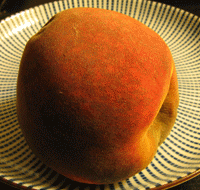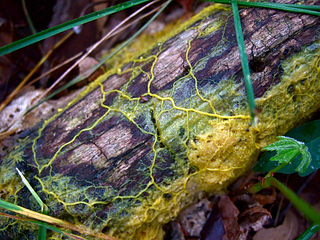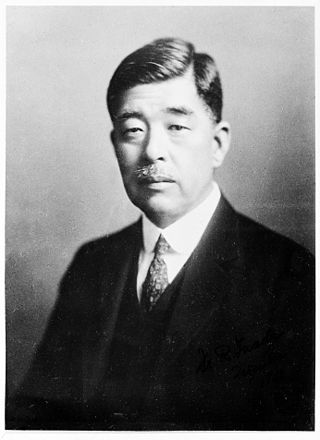Related Research Articles

Slime mold or slime mould is an informal name given to a polyphyletic assemblage of unrelated eukaryotic organisms in the Stramenopiles, Rhizaria, Discoba, Amoebozoa and Holomycota clades. Most are microscopic; those in the Myxogastria form larger plasmodial slime molds visible to the naked eye. The slime mold life cycle includes a free-living single-celled stage and the formation of spores. Spores are often produced in macroscopic multicellular or multinucleate fruiting bodies that may be formed through aggregation or fusion; aggregation is driven by chemical signals called acrasins. Slime molds contribute to the decomposition of dead vegetation; some are parasitic.

A mold or mould is one of the structures that certain fungi can form. The dust-like, colored appearance of molds is due to the formation of spores containing fungal secondary metabolites. The spores are the dispersal units of the fungi. Not all fungi form molds. Some fungi form mushrooms; others grow as single cells and are called microfungi.

Mycetozoa is a polyphyletic grouping of slime molds. It was originally thought to be a monophyletic clade, but recently it was discovered that protostelia are a polyphyletic group within Conosa.

Kyushu University, abbreviated to Kyudai, is a public research university located in Fukuoka, Japan, on the island of Kyushu.

Osaka University, abbreviated as OU or Handai (阪大), is a national research university in Osaka, Japan. The university traces its roots back to Edo-era institutions Tekijuku (1838) and Kaitokudo (1724), and was officially established in 1931 as the sixth of the Imperial Universities in Japan, with two faculties: science and medicine. Following the post-war educational reform, it merged with three pre-war higher schools, reorganizing as a comprehensive university with five faculties: science, medicine, letters, law and economics, and engineering. After the merger with Osaka University of Foreign Studies in 2007, Osaka University became the largest national university in Japan by undergraduate enrollment.

The Order of Culture is a Japanese order, established on February 11, 1937. The order has one class only, and may be awarded to men and women for contributions to Japan's art, literature, science, technology, or anything related to culture in general; recipients of the order also receive an annuity for life. The order is conferred by the Emperor of Japan in person on Culture Day each year. It is considered equivalent to the highest rank of the Order of the Rising Sun, the Order of the Sacred Treasure, and the Order of the Precious Crown. The only orders that Japanese emperors bestow on recipients by their own hands are the Collar of the Supreme Order of the Chrysanthemum, the Grand Cordon of each order, and the Order of Culture.
Yoshimoto Kogyo Holdings Co., Ltd. is a Japanese entertainment conglomerate. It was founded in 1912, Osaka, as a traditional theatre, and has since grown to be one of the most influential companies in Japan, employing most of Japan's popular owarai (comedy) talent, producing and promoting the shows they appear in. The two main headquarters are stationed in Osaka and Tokyo.
Microbial intelligence is the intelligence shown by microorganisms. The concept encompasses complex adaptive behavior shown by single cells, and altruistic or cooperative behavior in populations of like or unlike cells mediated by chemical signalling that induces physiological or behavioral changes in cells and influences colony structures.

Physarum polycephalum, an acellular slime mold or myxomycete popularly known as "the blob", is a protist with diverse cellular forms and broad geographic distribution. The “acellular” moniker derives from the plasmodial stage of the life cycle: the plasmodium is a bright yellow macroscopic multinucleate coenocyte shaped in a network of interlaced tubes. This stage of the life cycle, along with its preference for damp shady habitats, likely contributed to the original mischaracterization of the organism as a fungus. P. polycephalum is used as a model organism for research into motility, cellular differentiation, chemotaxis, cellular compatibility, and the cell cycle.
John Tyler Bonner was an American biologist who was a professor in the Department of Ecology and Evolutionary Biology at Princeton University. He was a pioneer in the use of cellular slime molds to understand evolution and development over a career of 40 years and was one of the world's leading experts on cellular slime moulds. Arizona State University says that the establishment and growth of developmental-evolutionary biology owes a great debt to the work of Bonner's studies. His work is highly readable and unusually clearly written and his contributions have made many complicated ideas of biology accessible to a wide audience.

Toshihide Maskawa was a Japanese theoretical physicist known for his work on CP-violation who was awarded one quarter of the 2008 Nobel Prize in Physics "for the discovery of the origin of the broken symmetry which predicts the existence of at least three families of quarks in nature."

Ryukichi Inada was a Japanese physician, prominent academic, and bacteriologist researcher. He discovered the Weil's disease pathogen. In addition to his life's work in early 20th-century Japanese medical education, he was a pioneer in Japanese clinical cardiology and oncology.

Sir Andre Konstantin Geim is a Russian-born Dutch–British physicist working in England in the School of Physics and Astronomy at the University of Manchester.
The Mathematical Society of Japan is a learned society for mathematics in Japan.
Andrew Adamatzky is a British computer scientist, who is a Director of the Unconventional Computing Laboratory and Professor in Unconventional Computing at the Department of Computer Science and Creative Technology, University of the West of England, Bristol, United Kingdom.
Research into the hypoalgesic effect of swearing has shown that the use of profanity can help reduce the sensation of pain. This phenomenon is particularly strong in people who do not use such words on a regular basis.

Tasuku Honjo is a Japanese physician-scientist and immunologist. He won the 2018 Nobel Prize in Physiology or Medicine and is best known for his identification of programmed cell death protein 1 (PD-1). He is also known for his molecular identification of cytokines: IL-4 and IL-5, as well as the discovery of activation-induced cytidine deaminase (AID) that is essential for class switch recombination and somatic hypermutation.

Hiroshi Amano is a Japanese physicist, engineer and inventor specializing in the field of semiconductor technology. For his work he was awarded the 2014 Nobel Prize in Physics together with Isamu Akasaki and Shuji Nakamura for "the invention of efficient blue light-emitting diodes which has enabled bright and energy-saving white light sources".
Toshiyuki Nakagaki is a Japanese professor, biologist, ethologist at the Research Institute of Electronic Science (RIES). He is famous for leading experiments relating to slime mold, specifically its ability to solve mazes as a lifeform without a brain.
References
- ↑ "Kyushu University, Atsushi Tero profile". kyushu-u.elsevierpure.com.
- ↑ Tsang, Jennifer (July 24, 2017). "How Slime Molds Affect Philosophy". www.mbl.edu.
- ↑ Starr, Michael (November 6, 2022). "Slime Molds Redefine Intelligence". www.sciencealert.com.
- ↑ Metcalfe, John (July 23, 2012). "Mapping Tokyo's Railway Using Slime Molds". www.bloomberg.com.
- ↑ Yong, Ed (2010-09-08). "Let slime moulds do the thinking!". The Guardian. ISSN 0261-3077 . Retrieved 2024-01-03.
- ↑ "Better transit design through ... slime mold?". NBC News. 2010-01-21. Archived from the original on January 21, 2021. Retrieved 2024-01-03.
- ↑ Masatoshi, Shimizu (March 24, 2017). "Maze-Solving Slime Mold Ig Nobel Prize". www.nippon.com.
- ↑ Wilton, Pete (Oct 1, 2010). "Slime Mold Transportation Ig Nobel Prize". www.ox.ac.uk.